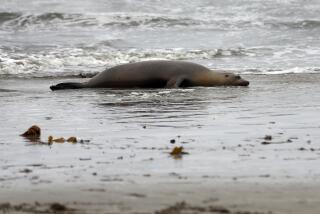Slaughter of Sharks for Fins Cuts Deep With Schoolkids
Shark-fin soup will never be their cup of tea.
To the contrary, fifth-graders at Nora Sterry Elementary School in Los Angeles think something is very fishy about the way the top-level predators are being treated these days.
The children seem fully aware that sharks are not the vicious, cold-blooded killers they’ve been portrayed to be for so many years. They realize that sharks are vital members of the ocean’s ecosystems, kill only for food, are slow to reproduce and, thus, are highly vulnerable to overfishing.
As for amputating their fins and throwing the animals overboard to die a slow and cruel death, the kids have no taste for that.
They made this quite clear this week in a series of letters they’re sending to Mexican government officials “to protest about the poachers killing life from the ocean.”
The letter-writing campaign was prompted by last week’s column describing the illegal actions of commercial fishermen using gill-nets in the protected waters of the Mexico’s remote Revillagigedo Islands.
The four-island archipelago, more than 200 miles southwest of Baja California and more than 350 miles from mainland Mexico, was federally protected as a “biosphere reserve” in 1994 because of its uniqueness and fragility.
Witnesses say the commercial fishermen, carrying permits to fish for sharks but not within 12 miles of the islands, netted more than 2,000 sharks during at least a four-day spree aboard several Mexican-flagged boats. The sharks had their fins removed--for sale in Asian markets--and at least some fin-less animals were tossed overboard alive.
The poachers also killed sea turtles and at least one giant Pacific manta. Photographs of sea creatures struggling and dying in the nets were taken by noted free-diver Terry Maas, who has an impressive display that might interest schoolchildren everywhere (especially those with a taste for shark-fin soup) on his Web site at https://www.freedive.net.
The number of sharks killed was disputed by Mexico’s environmental secretary, who promised nonetheless to keep a closer eye on the islands and to pursue prosecution of the fishermen.
In one of the letters, Kalyn Robinson and Efrain Santiago expressed, “The article made us feel sad, mad, frustrated, disappointed, bad, sorry, and almost made us cry. We feel this way because sharks are part of ocean life and they are going to be extinct.
“How would you feel if you went scuba diving or swimming one day and you got caught in a net and then a man cut off your legs and threw you into the ocean and you couldn’t swim without your legs and you would drown and die on the ocean floor?”
In another, Audelina Miguel and Jorge Ramirez reasoned that “sharks are living creatures like us” and suggested that Mexico prevent future raids on the Revillagigedos “by charging a $1-million fine” for poachers caught in the act.
Valerie Lozano wrote, “I felt like crying when I read that article, it’s so sad. Sharks don’t deserve what those poachers did. I can’t believe someone would do that. How about cutting their arms off and see how they like it.
“I think there should be more patrol guards out there so it won’t happen again. It should be very safe for the sea animals. Please use the guards. I want you to take care of the animals in that area. I want you to make sure it never happens again!”
That’s asking a lot, of course. But it’s refreshing to see that the “Jaws” mentality is fading from the minds of children. And the letters to Mexico surely couldn’t hurt.
As for shark-fin soup, it must be pretty good. Dried fins are worth up to $40 a pound in Asian markets. Thus, the catching of sharks solely for their fins has become as lucrative as it is controversial.
Fortunately, the movement to curb the practice, in U.S. waters anyway, is gaining momentum. The landing of amputated fins is already banned along the Atlantic, Gulf of Mexico and California coasts, and legislation is moving forward to prohibit it in Hawaii, where last year 34 tons of shark fins were brought in by the long-line fleet.
WHALE WATCHING
Nobody does whale watching like the Condor out of Santa Barbara’s Sea Landing, and its season began with a splash a few weeks ago as a killer whale munched a harbor seal in full view of the passengers.
Since then, the boat has been amid blue whales (sporadically, as it’s early yet), humpback whales and other marine creatures.
Bernardo Alps, president of the American Cetacean Society’s Los Angeles chapter, was aboard Wednesday and reported seeing 14 humpbacks that were breaching, lunge-feeding and basically hamming it up before all the camera flashes.
ACS-LA has trips scheduled June 24 and July 22. Details: (310) 519-8963. Sea Landing can be reached at (805) 963-3564.
SALTWATER FISHING
* Another excellent albacore season is anticipated, but the popular tuna seem reluctant to cooperate. Anglers aboard San Diego-based overnight boats have been posting sporadic catches at best, putting no more than 20 or 30 fish on the decks on a given day, but generally making up for it with decent scores of yellowtail.
* The phenomenal white seabass bite in the Santa Monica Bay seems to have bottomed out, though a few are being caught. Last Sunday, there were at least 100 boats fishing a small area in the southern portion of the bay. That in itself probably helped drive the fish away.
Meanwhile, Santa Cruz Island anglers are finding excellent action on seabass and yellowtail in mornings and afternoons. Top catch was a 58-pound yellowtail aboard Crusader.
Catalina and San Clemente islands have been producing only sporadically since midweek.
BOATING
Memorial Day weekend marks the traditional opening of the summer season. It’s also one of the busiest and most dangerous weekends on the water. A few things to consider:
* About 50 people will die nationwide this weekend as a result of boating mishaps. Most won’t be wearing life jackets and half will involve alcohol.
* There were 8,061 reported accidents nationwide in 1998, the last year for which figures are available. Of those, there were 815 fatalities and a record 4,612 injuries.
* California had the second-highest number of accidents, 770, in 1998. Florida was first with 1,255.
* Of the 815 fatalities, more than 700 occurred on boats 26 feet or smaller and nearly 500 were the result of capsizing or falling overboard.
For safety tips and other information, visit https://www.safeboatingcampaign.com, or https://www.boatus.com.
HUNTING
The California Fish and Game Commission approved the following changes for the 2000-2001 seasons:
* A new Roosevelt elk hunt on Simpson Timber Company land in Humboldt County, Aug. 30 through Sept. 8. Twenty-five either-sex tags will be issued.
* The removal of the 18,000 cap on bear-tag sales. More tags will be sold, but the hunt will still end when the kill reaches 1,500 animals.
* The elimination of pronghorn antelope doe tags because of a decline in pronghorn herds for the third consecutive season.
Other changes of note include a new deer-tag drawing system enabling hunters a better chance of hunting in their first-choice zones; the addition of three junior deer hunts, including two in Southland forests (Zones D-11 and D-19); a new bighorn sheep hunt in San Bernardino’s Sheephole Mountains; and extended tule elk seasons in parts of Northern California.
More information is available at https://www.dfg.ca.gov.
WINDING UP
Recent wildfires that displaced more than 20,000 residents of New Mexico’s Los Alamos area also have made it difficult for bears to find food and water.
They had been invading camps of firefighters and now are concentrating on area homes. In the camps, they were shooed away with rubber slugs fired from shotguns. Homeowners, meanwhile, are urged to arm themselves with safer weapons: “Super-Soaker” squirt guns filled with water and ammonia.
“The squirt guns will shoot 30 feet and we’ve had a lot of success using them [in other trouble spots] last year,” a conservation officer said in a news release.
Naturally, parents are urged to keep the ammonia-filled toys out of the reach of children.
More to Read
Sign up for Essential California
The most important California stories and recommendations in your inbox every morning.
You may occasionally receive promotional content from the Los Angeles Times.









